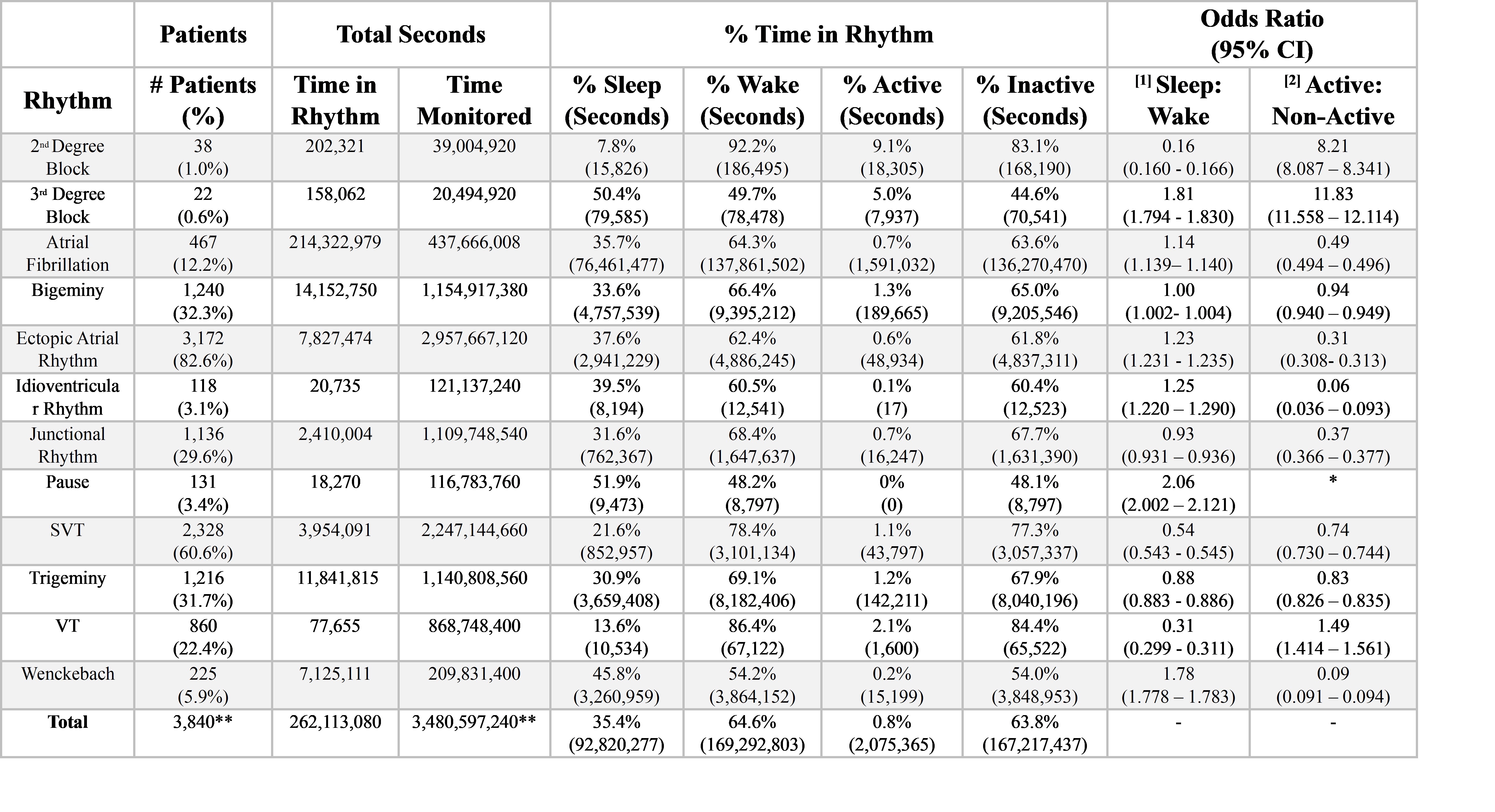Final ID: Mo2148
Characterization of Arrhythmia Occurrence During Sleep and Activity in Patients Undergoing Long-Term Continuous Ambulatory ECG Monitoring
Abstract Body (Do not enter title and authors here): Background
Circadian patterns of arrhythmias based on time of occurrence have been described in small datasets, but there is little information on the relationship of arrhythmia occurrence to sleep and activity. We sought to quantify the occurrence of arrhythmias detected by long-term (≤14 days) continuous ambulatory ECG monitoring (LTCM) during sleep, wake, and activity.
Methods
We performed a retrospective analysis of consecutive patients who underwent LTCM with an FDA cleared device that features an embedded accelerometer (Zio® Monitor, iRhythm Technologies, Inc.; San Francisco CA). This feasibility analysis included nationwide patients for whom LTCM ECG data were processed on a single day (Feb 1, 2024).
We applied an AI algorithm previously developed and validated as a wellness feature to classify periods of sleep, activity (≥2mph walking), and inactivity using LTCM accelerometry data. Rhythms were classified by an FDA-cleared deep learning algorithm, confirmed by a cardiographic technician and time-aligned to the algorithm-generated sleep/wake and activity/inactivity labels. Odds ratios (OR) associated with time in arrhythmia for sleep and activity periods were calculated by rhythm type.
Results
Analysis included 3,840 patients (58.3% female, age 59.7±19.7 years) monitored for an average 10.5 days (Table 1); patients spent the most time in AF. Rhythms with the highest association with sleep (vs. wake) were pause (OR=2.06; 95% CI 2.00-2.12) and 3rd degree block, (OR=1.81; 95% CI 1.79-1.83). Notably, VT was among the arrhythmias least likely to occur during sleep (OR=0.31; 95% CI 0.30-0.31). Second degree (Mobitz type 2) and third degree block had the highest OR associated with activity.
Conclusion
This is the largest study characterizing sleep, wake, and activity of ambulatory arrhythmias — and obtained from only a single day of data. Results demonstrate the feasibility of integrating sleep and activity labeling with LTCM findings and the potential to give context to arrhythmias, such onset or termination during sleep, wake, or exertion.
Circadian patterns of arrhythmias based on time of occurrence have been described in small datasets, but there is little information on the relationship of arrhythmia occurrence to sleep and activity. We sought to quantify the occurrence of arrhythmias detected by long-term (≤14 days) continuous ambulatory ECG monitoring (LTCM) during sleep, wake, and activity.
Methods
We performed a retrospective analysis of consecutive patients who underwent LTCM with an FDA cleared device that features an embedded accelerometer (Zio® Monitor, iRhythm Technologies, Inc.; San Francisco CA). This feasibility analysis included nationwide patients for whom LTCM ECG data were processed on a single day (Feb 1, 2024).
We applied an AI algorithm previously developed and validated as a wellness feature to classify periods of sleep, activity (≥2mph walking), and inactivity using LTCM accelerometry data. Rhythms were classified by an FDA-cleared deep learning algorithm, confirmed by a cardiographic technician and time-aligned to the algorithm-generated sleep/wake and activity/inactivity labels. Odds ratios (OR) associated with time in arrhythmia for sleep and activity periods were calculated by rhythm type.
Results
Analysis included 3,840 patients (58.3% female, age 59.7±19.7 years) monitored for an average 10.5 days (Table 1); patients spent the most time in AF. Rhythms with the highest association with sleep (vs. wake) were pause (OR=2.06; 95% CI 2.00-2.12) and 3rd degree block, (OR=1.81; 95% CI 1.79-1.83). Notably, VT was among the arrhythmias least likely to occur during sleep (OR=0.31; 95% CI 0.30-0.31). Second degree (Mobitz type 2) and third degree block had the highest OR associated with activity.
Conclusion
This is the largest study characterizing sleep, wake, and activity of ambulatory arrhythmias — and obtained from only a single day of data. Results demonstrate the feasibility of integrating sleep and activity labeling with LTCM findings and the potential to give context to arrhythmias, such onset or termination during sleep, wake, or exertion.
More abstracts on this topic:
Beyond the Beat: Mobile Health Technology Reveals Hidden Sleep-Activity-Mood Connections in Community-Dwelling Heart Failure Patients
Huang Tsuey-yuan, Tsai Ming-fen, Moser Debra
A Machine Learning Algorithm to Detect Pediatric Supraventricular Tachycardia Risk from Baseline ECGsArezoumand Amirhossein, Danala Gopichandh, Masnadi Khiabani Parisa, Ebert David, Behere Shashank

